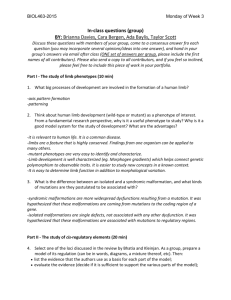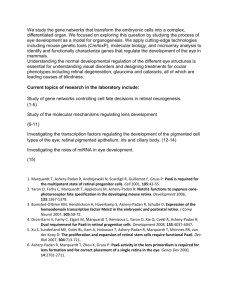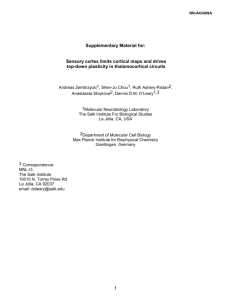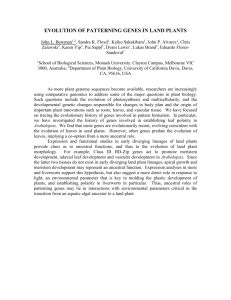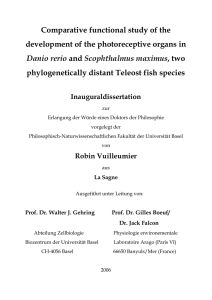The homologous origin of analogous structures
advertisement
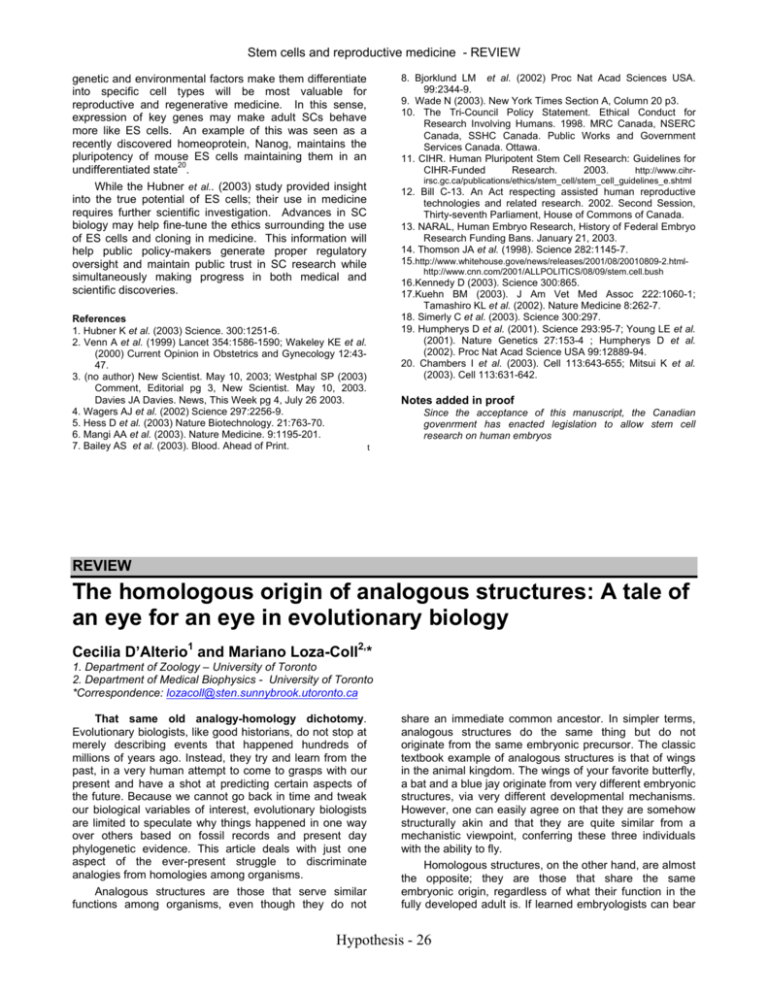
Stem cells and reproductive medicine - REVIEW genetic and environmental factors make them differentiate into specific cell types will be most valuable for reproductive and regenerative medicine. In this sense, expression of key genes may make adult SCs behave more like ES cells. An example of this was seen as a recently discovered homeoprotein, Nanog, maintains the pluripotency of mouse ES cells maintaining them in an 20 undifferentiated state . While the Hubner et al.. (2003) study provided insight into the true potential of ES cells; their use in medicine requires further scientific investigation. Advances in SC biology may help fine-tune the ethics surrounding the use of ES cells and cloning in medicine. This information will help public policy-makers generate proper regulatory oversight and maintain public trust in SC research while simultaneously making progress in both medical and scientific discoveries. References 1. Hubner K et al. (2003) Science. 300:1251-6. 2. Venn A et al. (1999) Lancet 354:1586-1590; Wakeley KE et al. (2000) Current Opinion in Obstetrics and Gynecology 12:4347. 3. (no author) New Scientist. May 10, 2003; Westphal SP (2003) Comment, Editorial pg 3, New Scientist. May 10, 2003. Davies JA Davies. News, This Week pg 4, July 26 2003. 4. Wagers AJ et al. (2002) Science 297:2256-9. 5. Hess D et al. (2003) Nature Biotechnology. 21:763-70. 6. Mangi AA et al. (2003). Nature Medicine. 9:1195-201. 7. Bailey AS et al. (2003). Blood. Ahead of Print. t 8. Bjorklund LM et al. (2002) Proc Nat Acad Sciences USA. 99:2344-9. 9. Wade N (2003). New York Times Section A, Column 20 p3. 10. The Tri-Council Policy Statement. Ethical Conduct for Research Involving Humans. 1998. MRC Canada, NSERC Canada, SSHC Canada. Public Works and Government Services Canada. Ottawa. 11. CIHR. Human Pluripotent Stem Cell Research: Guidelines for http://www.cihrCIHR-Funded Research. 2003. irsc.gc.ca/publications/ethics/stem_cell/stem_cell_guidelines_e.shtml 12. Bill C-13. An Act respecting assisted human reproductive technologies and related research. 2002. Second Session, Thirty-seventh Parliament, House of Commons of Canada. 13. NARAL, Human Embryo Research, History of Federal Embryo Research Funding Bans. January 21, 2003. 14. Thomson JA et al. (1998). Science 282:1145-7. 15.http://www.whitehouse.gove/news/releases/2001/08/20010809-2.htmlhttp://www.cnn.com/2001/ALLPOLITICS/08/09/stem.cell.bush 16.Kennedy D (2003). Science 300:865. 17.Kuehn BM (2003). J Am Vet Med Assoc 222:1060-1; Tamashiro KL et al. (2002). Nature Medicine 8:262-7. 18. Simerly C et al. (2003). Science 300:297. 19. Humpherys D et al. (2001). Science 293:95-7; Young LE et al. (2001). Nature Genetics 27:153-4 ; Humpherys D et al. (2002). Proc Nat Acad Science USA 99:12889-94. 20. Chambers I et al. (2003). Cell 113:643-655; Mitsui K et al. (2003). Cell 113:631-642. Notes added in proof Since the acceptance of this manuscript, the Canadian govenrment has enacted legislation to allow stem cell research on human embryos REVIEW The homologous origin of analogous structures: A tale of an eye for an eye in evolutionary biology Cecilia D’Alterio1 and Mariano Loza-Coll2,* 1. Department of Zoology – University of Toronto 2. Department of Medical Biophysics - University of Toronto *Correspondence: lozacoll@sten.sunnybrook.utoronto.ca That same old analogy-homology dichotomy. Evolutionary biologists, like good historians, do not stop at merely describing events that happened hundreds of millions of years ago. Instead, they try and learn from the past, in a very human attempt to come to grasps with our present and have a shot at predicting certain aspects of the future. Because we cannot go back in time and tweak our biological variables of interest, evolutionary biologists are limited to speculate why things happened in one way over others based on fossil records and present day phylogenetic evidence. This article deals with just one aspect of the ever-present struggle to discriminate analogies from homologies among organisms. Analogous structures are those that serve similar functions among organisms, even though they do not share an immediate common ancestor. In simpler terms, analogous structures do the same thing but do not originate from the same embryonic precursor. The classic textbook example of analogous structures is that of wings in the animal kingdom. The wings of your favorite butterfly, a bat and a blue jay originate from very different embryonic structures, via very different developmental mechanisms. However, one can easily agree on that they are somehow structurally akin and that they are quite similar from a mechanistic viewpoint, conferring these three individuals with the ability to fly. Homologous structures, on the other hand, are almost the opposite; they are those that share the same embryonic origin, regardless of what their function in the fully developed adult is. If learned embryologists can bear Hypothesis - 26 Homologous genes in analogous structures - REVIEW with us, homologous structures are those that often leave you mouth-open in trivia games, things like “did you know that your nails are like the feathers of a bird?” One of the most profound impacts of the last decade of research in developmental biology has been the realization that the development of a large number of what were previously thought to be analogous structures in diverse animal Phyla is in fact regulated by homologous genes, to the point that the non-homologous origin of such structures is questioned. In other words, what developmental molecular biologists have recently discovered is that the same genes and genetic regulatory networks seem to be sometimes used to transform totally unrelated embryonic structures into totally different organs… that serve the same function! A very crude comparison would be as follows: imagine that you could build a cargo train and a trailer truck with different raw materials but the exact same instructions and toolbox. Phyla are large taxonomic groups that share some characteristic and a very basic body plan. Do not worry much about Phyla for now, but keep in mind that when we start discussing biological features spanning various animal Phyla we are suddenly bringing together very distant organisms. In this paper, for example, we will be making arguments based on how distant and yet how similar you and a lobster are. By now, you may be either bored to death or craving for an example. Fine, here it is: the eye. Until recently, most biologists agreed that the eyes in different animal Phyla had evolved separately down their own routes, giving rise to true analogous structures. Moreover, the animal eye was often used as an example of evolutionary convergence, i.e. an example of how natural selection can “push” different evolutionary lineages to develop strikingly complex but somewhat similar structures based on their great adaptive value2,3. However, the evolutionary independent origin of eyes has been recently challenged by the observation that, regardless of how structurally different eyes are among animal Phyla, some genetic mechanisms directing their development seem to be highly conserved. These findings force us to re-think whether or not the eyes of different groups had truly different evolutionary origins, and support the alternative hypothesis that all eye types actually descend from some sort of photoreceptor “proto-eye” built with such ancestral genetic instructions, which later evolved into all modern types of eyes. Eyes that are structurally very different are found across Phyla, but in all cases they manage to fulfill the same basic function: to sense light and form an image of the surrounding environment (i.e. the first condition for 1 evolutionary analogy, “similar function”, is met) . Indeed, the range of structures that form what we call an “eye” is so vast that it makes it very difficult to define one, even from an engineering viewpoint. Some eyes collect light through an aperture and focus it with a lens onto specialized photoreceptor cells; in others, carefully arranged, fully exposed phototransducing cells directly absorb light. Among eyes with lenses, some have refracting lenses while others have reflecting ones1. The explosive evolution of eyes happened during the Cambrian, when three Phyla emerged with functional eyes capable of obtaining an optical image: Mollusks (snails), Arthropods (crustaceans, insects, arachnids and some very weird looking creatures, the trilobites) and Chordates (vertebrates and cartilaginous fishes) (see note 2). Pax6: the original sinner. The molecular evidence that first challenged the concept that different eye types evolved separately in unrelated ancestors is related to a very well conserved gene called Pax6. This so-called “eye master gene” can trigger some aspect of the eye developmental programs in many Phyla, ranging from the expression of some eye-specific proteins (see below) to the formation of an entire functional eye. For example, mutations of the Pax6 homologue in the fruit fly Drosophila 5 melanogaster cause the eyeless phenotype (ey) . (see note 3)Moreover, gene-swapping experiments showed that Pax6 homologues from one species could often trigger eye-development-related processes in several other Phyla. Thus, if you reintroduce a functional copy of eyeless or, even better, a copy of the mammalian Pax6 gene into flies carrying a mutant Pax6 gene, as long as you do it “in the right place at the right time”, you can restore the formation of an entire, functional normal eye. Most strikingly, the ectopic expression of Pax6 in other embryonic structures, like those that will form the thoracic region, results in the generation of ectopic eyes (yes, you get a fly with eyes on its chest!). In Xenopus (frog) embryos, the forced misexpression of Pax6 induces the formation of ectopic lenses6, whereas in chicken embryos, co-expression of Pax6 and a gene called Sox2 can induce expression of lens-specific crystallin genes in tissues other than the eye 4 . The simplest explanation for the common involvement of Pax6 in the development of different eye types is that it was employed in the formation of an ancestral common “primitive photosensitive unit” or proto-eye and that, later in evolution, different Phyla simply took on different designs 10 for their fully developed eyes . In fact, this proposal is further supported by the observation that similar molecules, called opsins, are involved in absorbing light once the fully developed eye has been formed in 2 vertebrates, cephalopods and insects . Furthermore, Pax6 can regulate the expression of opsins, which suggests that Pax6 and opsin may have already existed as a module in 2 the putative protoeye . Pax6 is a transcription factor with a number of DNAbinding domains. Interestingly, specific mutations in different modes of DNA binding by Pax6 affect the development of different eye structures, which suggests that once Pax6 was recruited into a very basic eye development program, further refinement followed making 4 use of the many potential transcriptional effects of Pax6 . Some evolutionists found it always difficult to believe in the convergent evolution of eyes, even before Pax6 appeared on stage. The argument at hand is not new… In fact, Sir Charles Darwin first put it forth soon after the publication of The Origin of Species. His theory of descent with modifications on pre-existing structures with a given fitness could easily explain the fine-tuning of the dimensions and shape of beaks among the Galapagos’s finches. When those finches first got there, they had fully functioning beaks, and all natural selection did was to force some changes in their design. But how could one explain, he was soon confronted, that structures as complex as the animal eye would evolve if only a fully Hypothesis - 27 Homologous genes in analogous structures - REVIEW formed eye can confer selective advantage? How could organisms get to modern eyes from no eyes based on trial and error modifications? What directed the evolution of eyes until a final functioning design was reached? His opponents rightly argued that, unlike the example of the finches’ beaks, slightly imperfect eye architectures that conferred no vision whatsoever could never have shown the differential vision that natural selection needed to work on. It did not matter, they argued, how far or close ancestral organisms were from finally having a fully functional eye, for they were all blind and, therefore, they could not be selected for or against based on their different pre-eye designs. Darwin argued back saying that there must have been some sort of proto-eye that was not even remotely as effective as modern eyes but that did confer organisms with visual cues. Such proto-eyes, he argued, would have accumulated modifications mounting to the complexity of present day eyes, conferring organisms with ever slightly more selective advantages. Of course, once we accept that the eye in different Phyla may have followed a continuous sequence of structures with slightly increasing adaptive value, it becomes possible to link them all together in a common starting point. Clearly, even though Darwin did not argue in favor or against it, the idea of one common ancestral proto-eye was always there, and Pax6 came only to reinforce it. Shortly after, Pax6 was not to be alone. Eye fate in Drosophila is in fact determined by the combined activity of seven key genes that, like eyeless, have been identified based on loss of function phenotypes and their ability to induce ectopic eyes when expressed in non-eye embryonic primordia. They are all linked to each other in a complex network of interactions that include feedback regulation of each other’s transcriptions and proteinprotein interactions among them. Many homologues for these genes were found in vertebrates and they are expressed in embryonic or adult eye tissues, although their 7 functional relationship is not as clear yet . These complex interactions can be summarized in diagrams that resemble more a “master regulatory network” than one “master 8 gene” as originally proposed . Those in favor of a common origin for all eye types will say that this only reinforces the hypothesis. If we were for a moment afraid of a coincidental “abuse” of Pax6 across Phyla as an eye-determining gene among independent ancestral proto-eyes, we ended up with conserved entire genetic networks regulating the development of eyes at two different organogenic levels. That cannot be mere coincidence - or can it? There is nothing to impede that independently evolving soon-to-be analogous structures pick similar molecular components and regulators during evolution. However, like with other attempts at explaining events of the past, all we can do is gather as much information as we can and use our judgment to speculate how likely certain sequence of events might be. Then, how likely is that all independently evolving eye-developing lineages picked Pax6 to build an eye? Somewhat ironically, a deeper understanding of how Pax6 initiates eye formation and how its expression is regulated allows 14 us to start considering such a possibility . It is now accepted that genes of the Pax6 family are necessary but they are neither sufficient nor restricted to determining eye fate. For example, ectopic expression experiments showed that not all the cells expressing the “eye specification” genes differentiate as eyes; only certain domains in the non-eye embryonic structures are so plastic. On the other hand, eyeless mRNA expression was found in regions of the nervous system of flies that do not participate in the formation of eyes. Similarly, the phenotype of Pax6 knockout mice is not restricted to defects in eye formation. They have no eyes, but they also 5 have no nose and extensive brain damage . Because the expression of Pax6 is not restricted to the mouse eye primordium but also found in the nasal epithelium, specific regions of the brain and the spinal cord, the phenotypes observed in the Pax6 null mice would not be explained by some indirect consequence of early embryonic defects in the developing eye. Another striking example of how the sole expression of Pax6 homologues is not sufficient for driving eye formation is the one of Caenobarditis elegans (another model organism for the study of genetics), which expresses Pax6 in diverse neural tissues but has no eyes. In addition, Pax6 homologues are expressed in tissues of diverse embryologic origin that will converge in the formation of a functional eye. During eye development in mammals, for example, Pax6 is expressed not only in the optic vesicle that gives rise to the retina but also in the overlying ectoderm that will form the lens and the cornea. How can we reconcile this observation with the idea of a very simple proto-eye likely formed by the action of the Pax6 master network acting in a very limited group of photosensitive cells? How could the development of such proto-eye that likely originated from a very simple and embryonically homogeneous group of cells have split into diverse primordia to form a fully functional eye? Of course, defenders of the theory of a common evolutionary origin for all eye types will argue that the proto-eye did not split its embryonic origins during evolution but that it recruited an ever increasing and more complex set of structures generated by other embryological tissues. Thus, in the case of the vertebrate eye for an example, there was a photosensitive proto-eye that slowly wrapped itself up with ectodermal tissues that would protect them from damage. Later on, those layers of ectodermal tissue would slowly evolve curvatures and a molecular make up that allowed the focusing of incoming light beams into the retina leading to a sharper image. But then, how is it possible that all these tissues of different embryological origin that were sequentially recruited by the original proto-eye picked the Pax6 master-network to develop into structures that contributed to the function of the eye? It gets worse. Critical to the development of any structure is the signaling between embryonic cells to produce a pre-existing body pattern that precedes the actual functioning of an “X” master genetic network. For instance, it was shown in Drosophila that the so-called Notch and EGFR signaling pathways influence the position of cells that will respond to the eye determination genetic 9 networks . Also, the role of Notch signaling in directing Pax6-mediated formation of eye structures was recently confirmed in frog embryos as well12. Thus, even though the network of eye determination genes will not function during the formation of the eye primordia but once they are formed and closer to terminal eye differentiation, its function will be directed and restricted to the eye primordium by intercellular signaling pathways that are not genetically related to the eye-determining network itself. Hypothesis - 28 Homologous genes in analogous structures - REVIEW Then, where do we draw the line? If regulation of the eye determining networks by EGFR and Notch is also conserved among Phyla as a pre-requisite for the proper function of the Pax6 master regulatory network, can we say that all eyes have a common origin based on the universality of EGFR and Notch? Moreover, will we argue that the eye and other structures influenced by the Notch and EGFR pathways are, by the same token, also homologous? Summary and Discussion. Can we untangle this mess? Let us first summarize what we have so far. The seemingly central and conserved role of Pax6-like regulatory networks in structurally different developing eyes suggested it may have acted as an ancestral master gene for the development of a proto-eye that took on different design routes in branching evolutionary lineages. Furthermore, despite their very dissimilar eye differentiation mechanisms and final design, flies and vertebrates at least, share some upstream signals that allow this master network to specify an eye 12. The advocates of a single ancestral proto-eye will argue that it is impossible that all eye types originated separately and that they all fortuitously chose the EGFR/Notch-Pax6-like network combo as a master commander. That leaves them with three major problems. First, no one has been able to find that ancestral proto-eye capable of forming an image in the common ancestor of, say, flies and vertebrates. Of course, that is not to say it did not exist. In fact, if such proto-eye did indeed exist, it likely was very soft in nature and may have not printed itself well in fossil records. Second, how can we then explain the use of Pax6-like genes in extra-retinal primordia used to build structures that appeared much later in eye evolution? In principle, the only possible explanation seems to be that fortuitous coincidence they attack so fiercely in their argument against separate origins for all eye types based on the Pax6 evidence. Finally, their arguments rest upon an arguably labile premise: that Pax6-like molecules, EGFR and Notch do the same during the development of different eye types. From the additional functions inferred for Pax6 and our knowledge of the extensive range of known functions for EGFR and Notch in developmental processes, one could argue that Pax6, EGFR and Notch may be carrying out different functions at the molecular level in different Phyla. Thus, that they may have been chosen during convergent evolutionary processes for their usefulness in building image-capturing structures does not necessarily imply that they were chosen to perform the exact same function in each lineage. For instance, Pax6 binding sites have been found in the opsin gene, but it is yet to be determined whether Pax6 directs the expression of opsin or related genes in all these Phyla. The opponents of the theory, on the other hand, might claim that Pax6 was “in the right place at the right time” and that eyes separately originating in different Phyla picked it because there were only a very limited number of candidate networks to fulfill the position, and the Pax6 one was simply the best. After all, for example, Pax6 seems to have come molecularly wired to opsins, which made it a candidate second to none. Moreover, they might add, the same argument provides a simple explanation for the fact that Pax6 is expressed and functions outside of the retinal primordia, something that gives the other side such a bad headache. If natural selection kept choosing the most appropriate pre-existing regulatory networks for the elaboration of specialized structures, why not choosing Pax6 in extra-retinal primordia to build a lens in front of an evolving photo-transducing retina? The Pax6-like regulatory networks direct the expression of a number of genes, but they also respond accurately to developmental cues that position eyes spatially and temporally. Thus, if you were to build two structures synchronously during development (e.g. the photo-transducing unit and a lens to focus incoming light into it), would you not choose the same intracellular pathway to respond to the spatial and temporal cues that orchestrate such development? All you need to do is to change the set of downstream genes that respond to those cues. In other words, if Pax6 was responding so well to the EGFR/Notch signals in building the image-capturing structures, there may have been no better way for the extra-retinal primordia to coordinate their development with the retina than to choose Pax6 as their commander. In sum, what might seem a paradox between analogy and homology at the structural and genetic levels respectively may just be a consequence of a rather limited but plastic and efficient enough spectrum of genetic programs that were used once and again during evolution to generate the most diverse structures. Nothing like an open end for a good story. If the genetic programs were the same, how can the resulting structures be so different? Part of the answer was already given: if you have the same orchestra director but two totally different sets of instruments, you will hear dissimilar symphonies. All you need is the master regulatory network (Pax6) to command the expression of a different set of genes (opsin and crystallin), and you will generate a photo-transducing epithelium in one case (opsin), and a hardy lens in the other (crystallin). How shocking would you say it is, then, if we now told you that there are cases of master regulatory genes that, coordinating the expression of similar sets of genes, give rise to very diverse structures? Now you have the same director, the same instruments, and you still hear different music. There might be a way to explain such paradox. Unfortunately, we will have to discuss it in some later opportunity. Notes 1. It is necessary to clarify a very important point here (and we are thankful to the anonymous reviewer who brought it up!): One of the biggest obstacles in evolutionary developmental biology is to know where to draw certain lines. Nearly all living organisms sense and react to light, including plants and bacteria. Therefore, if the ability to sense light is common to all organisms (and given that some of the molecules involved in the process are somewhat similar) can we argue that the ability to “see” is much more ancestral than what we think? If so, would it not trivialize the discussion of whether eyes across certain animal groups are analogous or homologous? The important distinction to be made here is related to the ability of eyes to form an image. To our current knowledge, plants and bacteria average their surroundings into areas of different light intensity but do not form an image of their environment. It is that aspect of eye evolution what concerns us the most in this article, whether the imageforming structures are analogous or homologous. That said, it is true that if the basic genetic components underlying light absorption are very similar in nearly all living organisms, i.e. if they are very ancestral characters, then they should not be used to try and tell analogies from homologies, which is to be done based on derived characters instead. To our knowledge, no one Hypothesis - 29 Homologous genes in analogous structures - REVIEW has yet investigated to what extent the genetic networks discussed in this paper are involved in regulating the expression of light-absorbing molecules in plants or bacteria. 2. Can you think of any animal outside these taxonomical groups? It is hard for most of us, and that is why it seems like every animal on Earth has eyes. Well, our truly eyeless relatives in Animalia would be the marine sponges, sea urchins, starfishes, jellyfishes and a whole lot of marine and land worms. Other than those, animals with no eyes were theoretically bound to have them but lost them sometime later in evolution. 3. A quick, harmless comment about nomenclature in Drosophila genetics. Like with all other model organisms, genes in Drosophila were first identified based on their mutations, and they would typically inherit a name related to the phenotype caused by such mutations. Thus, one of the first genes found to be involved in forming an eye in Drosophila was “ironically” named eyeless, because its mutated version was first pinpointed in flies that had no eyes. Later on, as mutations and phenotypes started accumulating and became subtler, Drosophila geneticists turned more sophisticated and creative, which leaves you with genes like groucho, capuccino, zucchini, stardust, torpedo, bag-of-marbles, egalitarian, pepper corn, hedgehog, decapentaplegic, armadillo, traffic jam, spaghetti squash and our all-time favorite cubitus interruptus. References 1. Fernald, R (2000) Current Opinion in Neurobiology 10:444-450 2. Halder G et al. (1995) Current Opinion in Genetics and Development 5: 602-609 3. Salvini-Plawen LV and Mayr E (1977) Evol. Biol.10: 207-263 4. Chi N and Epstein J (2002) TRENDS in Genetics 18:41-47 5. Gehring W and Ikeo K (1999) Trends in Genetics 15:371-377 6. Chow R et al (1999) Development 126: 4213-4222 7. Hanson I.M (2001) Sem. Cell & Dev Bio. 12: 475-484 8. Kumar J and Moses K (2001) Sem. Cell & Dev Bio. 12: 469474 9. Baker N (2001) BioEssays 23: 763-766 10. Pichaud F et al (2001) Cell 105: 9-12 11. Kumar J and Moses K (2001) Cell 104: 687-697 12. Onuma Y et al (2002) PNAS 99: 2020-2025 13.Callaerts P et al (2001) J. Neurobiology 46: 73-88 14. Tabin CJ et al (1999). American Zoology 39: 650-663 REVIEW Evaluating Non-Conventional Treatments for Glaucoma: A Review Article Peter A. Zakrzewski1,*, Lukas Kus2 1. Department of Human Biology 2. Faculty of Medicine – University of Toronto *Correspondence: pete.zakrzewski@utoronto.ca In the summer of 2001, the Canadian federal government amended the Narcotic Control Regulations to allow the Marijuana Medical Access Regulations to come into force. The new legislation allowed for the use of marijuana by patients suffering from serious illnesses in cases where it was expected to have clinical benefits that outweighed potential risks. Cannabis helps alleviate symptoms of nausea, vomiting, and loss of appetite leading to weight loss in patients suffering from severe chronic diseases.1 More recently, the Canadian government has proposed legislation to decriminalize the possession of small amounts of marijuana. Decriminalization would allow convicted offenders to receive a monetary fine rather than face the prospect of a criminal record and potential jail time. These recent proposed and accepted legislation changes for relaxing marijuana enforcement have helped rekindle discussion and research into medicinal applications of marijuana and cannabinoids (a family of biologically active molecules found in marijuana) in both the medical and lay press. The first formal report of the use of cannabis as a medicine dates back nearly 5,000 years to China, where it was used as a treatment for malaria, constipation, joint pains, pain of childbirth, and, when mixed with wine, a 2 surgical anaesthetic. Subsequent records exist of its use throughout Asia, the Middle East, Southern Africa and South America. It did not become a mainstream medicine in Canada, USA, and Britain until the 19th century and peaked in popularity during the mid to late 19th century.1 Towards the end of the 19th century, the role of cannabis as a prescribed medicine began a steep decline in popularity due to concerns about its unpredictable potency and response to oral administration, as well as its poor storage stability. Increasing enthusiasm for synthetic alternatives and American concerns about its use as a recreational substance were also important factors. Although the renowned physician Sir William Osler was still recommending marijuana for migraine sufferers as late as 1913, cannabis was finally outlawed in 1928 by the ratification of the 1925 Geneva Convention on the 1 manufacture, sale and movement of dangerous drugs. Since that time, proponents have argued in favour of having cannabis reinstated as a viable medical treatment. Many lobby groups, for example, have advocated marijuana use for decades on behalf of chronic disease sufferers. Only the current social and political climate of acceptance and leniency towards marijuana use, however, Hypothesis - 30

